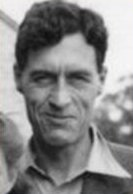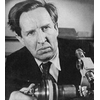A.B.C. of FREEDOM
HOME FORUM A.B.C. PART 2:I A.B.C. PART 2:II A.B.C. PART 2:III
The 'Tots and Quots'
Born in the 40’s in the darkness of ‘total war’ but first conceived in the deranged minds of the internationalist communist scientists of the 1930’s the arguments to employ tools of public manipulation to a scientific degree later gained credence under the reasoning that if the Nazis are doing it then we the democracies should do it too, and do it better.
This was how the members of the ‘Tots and Quots Dining Club’ (really a subversive organisation of young internationalist left wing scientists led by South African Jew Solly Zuckerman; ‘Anti-fascists’ as some groups today cryptically describe themselves) originally sold their plans for developing social control as a covertly maintained science to the hard pressed U.K. government of the day.
(From ‘Science in War’, a book authored by Solly Zuckerman and 25 of his “Tots and Quots” in 1940 [see below]: “ The democracies, pretending to respect the independent decision and opinion of every individual, feel shocked and guilty when the word propaganda whistles down Whitehall. But it is something, they realize, that you “have to have” nowadays in a war. So in this war they had to propagandize, and they have occupied more cubic space with propaganda personnel than all three Fascist States together do for theirs.”
(From ‘Science in War’, a book authored by Solly Zuckerman and 25 of his “Tots and Quots” in 1940 [see below]: “ The democracies, pretending to respect the independent decision and opinion of every individual, feel shocked and guilty when the word propaganda whistles down Whitehall. But it is something, they realize, that you “have to have” nowadays in a war. So in this war they had to propagandize, and they have occupied more cubic space with propaganda personnel than all three Fascist States together do for theirs.”
Solly Zuckerman had been born in Cape Town, South Africa in 1904 the second child and eldest son of Moses and Rebecca Zuckerman, children of Jewish immigrants. He was educated at South African College School. After studying medicine at the University of Cape Town he later attended the U.S. Ivy league Yale University. In 1926 he came to England to study at University College Hospital Medical School. In 1928 he began his career as a zoologist, whilst simultaneously working as a research anatomist.
Below: Solly Zuckerman

The years between the two world wars were exciting and empowering times for young men like Zuckerman, the rise of international communism and later fascism in Italy and Spain, Nazism in Germany and the more quiet ascendancy of unbridled internationalist capitalism centring on the great sea powers of Britain and the USA made this period the iconoclasts’ playground. The old world, it’s loyalties, traditions and ideals were dead, they had reached their climax in the first world war, the ‘great war’, ‘the war to end all wars’ as it had been known. God was dead, so to speak, it was up to men like Zuckerman to invent their own. This they did, all over the world an entire plethora of hare-brained theories abounded, science and pseudo-science based ideologies bloomed. These wonderfully empowering theories were welcomed by men like General Franco, Mussolini, Joseph Stalin and Adolph Hitler. Empowering theories are always welcomed by people who love power (personally I prefer truth, and I’ll take it any way it comes, but I digress). The nihilism of the scientific method (“nothing exists other than what I prove to exist”) provides a nice clean slate to the totalitarian, to imprint as he wills, especially once the method has been carried over into ‘political science’, and ‘social science’.
Zuckerman had drawn together his group of like minded politically left-wing scientists and influential supporters, the ‘Quots and Tots’, the nearest approximation with modern groups being the radical ‘anti-fascist’ groups that exist today. Their aim was to further their brand of ideology (a cross between science and international socialism, or communism) by infiltrating the highest levels of government on the basis that the way to counter the Nazi use of science was to mimic and surpass it. This wasn’t envisaging a role for scientists in the stuff like code braking or radar development, such provisions already existed, they wanted their role to be high level governance, the control of war planning, controlling the economy, directing industry, controlling the national diet and the invention and development of new ‘social sciences’ to better understand the masses alongside new pseudo-sciences of propaganda to manipulate them. They succeeded - stealing a march on the Nazis who only later in the war (when events started going badly for them) adopted full on this nihilistic approach to the matter of world domination, officially calling the policy “Total War”.
The inner core of the Tots and Quots included the scientists Solly Zuckerman, Patrick Blackett, Desmond Bernal, Julian Huxley, Joseph Needham, C. H. Waddington, C. D. Darlington, Lancelot Hogben, science journalists J. G. Crowther and Peter Ritchie Calder alongside leftwing up and coming political activists including at least two men who were to go on to become leaders of Labour Party in the turbulent years of the cold war, Harold Wilson and Hugh Gaitskell, one of whom was suspected by MI5 of being a KGB agent (Wilson) and one of whom was suspected of being murdered by KGB agents (Gaitskell; described below).
Below: Patrick Blackett

Membership of Zuckerman’s group reads like a who’s who of 20th century radical left-wing thinking, but it is important to consider that in the 1930’s when the group first began meeting these people were not the historic figures we know them as today. In that decade before the catastrophic events of 1940 brought them the opportunity to rise to prominence they were simply one of many radical groups dreaming utopian dreams of power. The core of the group, a group dedicated to a mixture of radical socialism and science which sought to - and succeeded in - reducing politics and control of society to a materialist experiment were such notable figures as the experimental physicist Patrick Blackett (later to become Baron Blackett), a noted and once vilified crypto-communist who’s post war political activities in Britain were said to be rooted in the shadowy “Fabian” brand socialism (‘The Fabian Society’ with it’s connections to powerful international industrialists and bankers is grooming key politicians, semi-openly, to this very day). Blackett later went on to be awarded a Nobel Prize for physics. Upon his death in 1974 The Times was to print that Blackett had been a “Radical Nobel-Prize Winning Physicist” who had been “committed too far to the left for [even] a Labour Government to employ with ease.” Although Blakett was by no doubt a competent physicist his criticism of the Allies in the closing stages of the second world war and later during the cold war combined together with his stringent support for the totalitarian communist states to outrage many, with America categorising Blackett as a Stalinist apologist.
In 1949 George Orwell himself included Patrick Blackett on a list of 38 key communist sympathisers which he prepared for the foreign office. Communist “fellow travellers” was the euphemism applied at the time to crypto-communists and Soviet sympathisers such as Blackett.
Below: J.D. Bernal

Alongside the young professors Zuckerman and Blackett at the core of the Tots and Quots was professor John Desmond Bernal, who was a card carrying member of the communist party of Great Britain from at least 1923. Bernal’s blind allegiance to the Soviet Union continued for his entire lifetime. In 1939 Bernal published “The Social Function of Science”. In “Marxism and the Philosophy of Science: A Critical History” Helena Sheehan writes on how the impetus provided by Bernal’s scientific approach to Marxism, and Marxist approach to science provided the lynch-pin for the spreading of Marxist doctrine through British society by way of such establishments as Cambridge. Sheehan is correct in recording this avenue of indoctrination as an effective one, simply considering the success of the Soviet/Cambridge spy-ring inclusive of Blunt, Burgess, Maclean and Philby confirms it as an effective route of indoctrination. Sheehan writes sympathetically about Bernal’s career and his motivations, which were unambiguous when it came to the relationship between science and ideology… “By the time he wrote The Social Function of Science, he had come to believe that: "In its endeavour, science is communism."
“Bernal's dominant theme was that … science could achieve its full potential only under a new socialist order.”
“Bernal's dominant theme was that … science could achieve its full potential only under a new socialist order.”
As well as lauding communist party member J.D. Bernal Sheehan also gives reference to another member of the Tots and Quots inner circle, science journalist J.G. Crowther who she describes interacting with both Bernal and Soviet science delegations.
Crowther was crypto-communist, or ‘fellow-traveller’ as the pseudonym described these types at the time. Crowther visited the Soviet Union on several occasions between 1930 and 1936 and made no attempt to hide his enthusiasm for the one-track politics there, but given the atmosphere in the British scientific community at the time, when science and communism were held by many ideological scientists to be the same thing it’s not surprising that he didn’t need to hide his allegiances. Early in the war in one of his many short books entitled ‘The Social Relations of Science’ he spouts an opinion that was common to all of the members of the Tots and Quots, stating that professional scientists could only expect to receive fair recognition and reward in a socialist society of the sort that regularly recoursed to such wonders as 3 year agricultural plans and a planned economy, were 'scientists' could monitor and control every aspect of citizens lives - just like in the USSR, what a coincidence - and also stated that scientists should be given authority over social policy in a capitalist society. These views were also made publicly by Bernal, Blackett and Joseph Needham.
Crowther became a new kind of journalist, one that the world had never seen before, a journalist who wrote only about science.
In 1939 Crowther was appointed the Director of the Science Department of the British Council, and from 1943 onwards this 'Science Department', invariably represented by Crowther himself, played an important part in creating the international cultural body which ultimately became UNESCO (United Nations Educational Science Cultural Organisation; see below). Indeed it is said that UNESCO would not of included a science component at all if it were not for the efforts of J.G. Crowther in persuading the U.N. to include science in it’s remit.
Another member of the inner-circle of the Tots and Quots was the scientist and communist sympathiser and collaborator Joseph Needham, later famed for his links with, and sympathetic studies of, communist China. In 1965 Needham was to establish the Society for Anglo-Chinese Understanding. Needham's biographer Simon Winchester comments that "Needham was intellectually in love with communism; and yet communist spymasters and agents, it turned out, had pitilessly duped him." Because of his activities Needham was Blacklisted by America.”
GO TO PAGE THREE Page 1 page 4 Page5
------------------------------------------------------------------------------------------------------------------------------------------------
HOME FORUM A.B.C. PART 2:I A.B.C. PART 2:II A.B.C. PART 2:III
------------------------------------------------------------------------------------------------------------------------------------------------
HOME FORUM A.B.C. PART 2:I A.B.C. PART 2:II A.B.C. PART 2:III